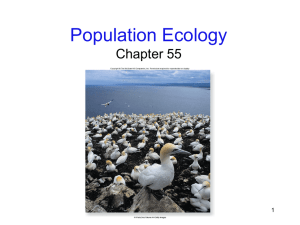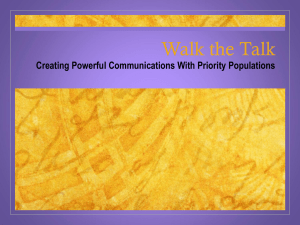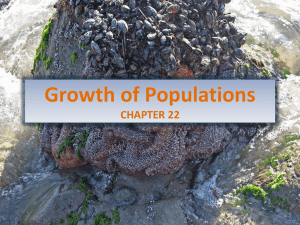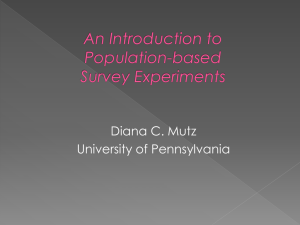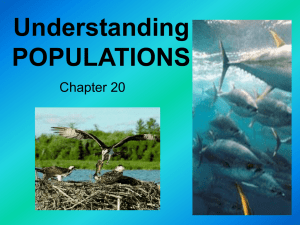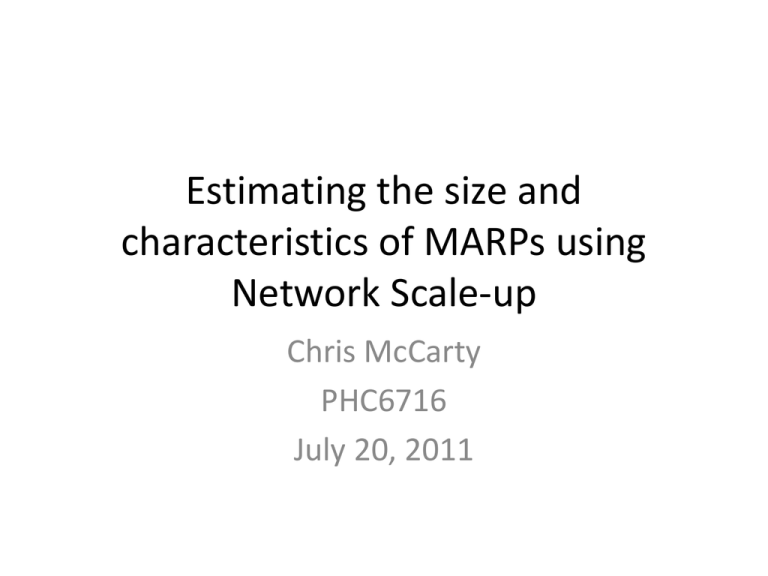
Estimating the size and
characteristics of MARPs using
Network Scale-up
Chris McCarty
PHC6716
July 20, 2011
The Problem
• Certain populations are at high risk for contracting and
spreading HIV
• Most At Risk Populations (MARPs) typically fall into one of
three categories
– Female Sex Workers
– Men Who Have Sex With Men
– IV Drug Users
• Members of all three populations engage in behavior that
increases the chance of contracting HIV
• All three populations are difficult to measure directly
What is known about MARPS?
• Many studies have been done to estimate the prevalence
of HIV among these populations, and to measure
characteristics of the populations
• Representative samples are drawn to estimate the
proportion of the population with HIV
• Unlike other sample surveys there is no known population
size to which these proportions can be applied
• This means that the size of the problem remains largely
unknown, particularly on a regional or local level
Methods to Estimate the Size of MARPs
(http://data.unaids.org/pub/Manual/2003/20030701_gs_estpopulationsize_en.pdf)
• Methods that require a sample frame
– Census
• Counting all members
– Enumeration:
• Counting members in a sample frame then scaling up
– Population Survey:
• Draw a representative sample (similar to enumeration)
• Methods that do not require a sample frame
– Capture-Recapture
– Multiplier
Capture-Recapture
• Method originated in biology to estimate the size of fish and wildlife
populations
• The method involves five steps:
1.
2.
3.
4.
5.
“Capture” a sample of subjects
Tag them
Release them back into the population
“Re-capture” a sample at a later time
Estimate the population size based no the proportions
•
With humans “tagging” is sometimes done by providing a unique object
•
Otherwise tagging is done by using information about respondent (e.g.
Social Security Number or other identifying characteristic)
Capture-Recapture (cont.)
• N=MC/R where:
–
–
–
–
N = Estimate of total population size
M = Total number captured and marked on the first visit
C = Total number captured on the second visit
R = Number of captured on the first visit that were recaptured on the
second visit
• Example: M=200, C=200, R=10 then N=200x200/10=4,000
• Assumes a closed system without in or out migration
• More complex models allow for multiple sites
Multiplier
• Relies on overlap of information between two sources:
1. Data on attendance by target population at an institution
that serves them (e.g. a clinic)
2. Data from target population about their attendance
•
Example
–
–
–
–
Clinic screened 3,500 sex workers in a two week period
A survey of 600 sex workers yielded 404 who said they
had been screened
The multiplier = 600/404 = 1.49
The population estimate = 3,500 x 1.49 = 5,215
Problems with these approaches
• All these methods require interviews with
members of the target population
• The Census, Enumeration and Population Surveys
require sample frames which are lacking for
hidden or elusive populations
• The Capture-Recapture and Multiplier methods
are difficult to do across large geographies
A note on RDS
•
Respondent Driven Sampling (RDS) is a method to measure the characteristics of
an elusive population (http://www.respondentdrivensampling.org/)
•
This starts as a snowball sample where respondents recruit other respondents
using coupons
•
Each respondent must report the names of others they know in the population
•
RDS requires completion of minimal chains without breaks (RDS does not work in
disconnected populations)
•
RDS is a weighting procedure that adjusts for the non-random procedure for
collecting the data
•
RDS will NOT give estimates of the size of a population
An Alternative: Network Scale-up
• This is a population-based survey approach that does
not require a sample frame of the target population
• The method relies on asking respondents (not
necessarily in the target population) about people they
know in the target population
– Not talking to the target population was politically
unpopular in the Ukraine
• This is a method developed over the past 20 years but
has recently gained recognition
Background on Network Scale-up
•
The idea came from Russ Bernard after the 1985 earthquake in Mexico City
•
Official reports estimated deaths at around 7,000
•
These estimates did not jibe with anecdotal reports from residents many whom
knew someone who died in the earthquake, and opposition newspapers who had
the death toll as high as 22,000
•
A study was conducted asking a random selection of 400 residents how many
people they knew who had died – 23 percent said they did
•
A model was created to estimate what their personal network size would have to
be to account for this high percentage – this suggested a much higher death rate
•
Later reports by the Red Cross established the deaths at more than 25,000
This suggests a primitive model
•
t = the size of a population (e.g.
Mexico City)
•
e = the size of some subpopulation
within it (e.g. all those who died in
the earthquake)
•
m = the number of people a
respondent knows in e
•
c = personal network size
•
Assumption: Everyone’s network in a
society reflects the distribution of
subpopulations in that society
m e
c t
New model
• We can use reports
about many populations
of known size to back
estimate personal
network size c
• Given an individual c
and reports of an
unknown population m
we can then backestimate e
t
L
ci
m
j 1 ij
L
e
j 1 j
What we did
• We conducted a series of telephone surveys
• For each respondent we asked how many people they knew in
populations of known size
• We also asked how many people they knew in populations of unknown
size with estimates from other sources
• We estimated the distribution of c and back-estimated e for each
unknown subpopulation
•
•
•
1998 Killworth, P.D., E.C. Johnsen, C. McCarty, G.A. Shelley, and H.R. Bernard. A Social Network Approach to
Estimating Seroprevalence in the United States. Social Networks 20:23-50.
1998 P. D. Killworth, C. McCarty, H. R. Bernard, G. A. Shelley, and E. C. Johnsen. Estimation of Seroprevalence, Rape
and Homelessness in the U.S. Using a Social Network Approach. Evaluation Review 22:289–308.
Killworth, P. D., C. McCarty, H. R. Bernard, G. A. Shelley, and E. C. Johnsen. Estimation of Seroprevalence, Rape and
Homelessness in the U.S. Using a Social Network Approach. Evaluation Review 22:289–308
Populations in survey
Known Population
Average
known
Known Population
Average
known
Unknown
Population
Average
known
Native Americans
3.5
Michael
4.8
HIV positive
Gave birth in past 12
months
Women who adopted a
child in past 12 months
Widow(er) under 65
years old
On kidney dialysis
3.6
Christina
1.3
0.3
Christopher
1.8
Women raped in past 12 0.2
months
Homeless
0.7
3.2
Jacqueline
0.7
0.6
James
3.4
Postal worker
2.2
Jennifer
2.3
Commercial pilot
0.7
Anthony
1.7
Member of Jaycees
1.1
Kimberly
1.4
Diabetic
3.3
Robert
4.1
Stephanie
1.3
David
3.5
Nicole
1.1
Opened a business in past 1.1
12 months
Have a twin brother or
2.0
sister
Licensed gun dealer
0.5
0.7
Estimates of unknowns
• RDD telephone survey of 1554 adults in the U.S. in
1994.
– Seroprevalence: 800,000 ± 43,000
– Homeless: 526,000 ± 35,000
– Women raped in the last 12 months: 194,000 ±
21,000
• These were all close to other estimates made with
various enumeration or surveillance methods.
•
1998 P. D. Killworth, C. McCarty, H. R. Bernard, G. A. Shelley, and E. C. Johnsen. Estimation of Seroprevalence, Rape
and Homelessness in the U.S. Using a Social Network Approach. Evaluation Review 22:289–308.
Estimates of c are reliable across
multiple surveys
• Across seven surveys, we consistently find an
average network size (c) of 290 (sd 232,
median 231).
• And 290 is not an average of averages. It’s a
repeated finding.
Is 290 is an artifact of the method?
• We tested this in three ways:
1. Make the estimates using a different
method.
2. Experiment with parameters and see
if the outcome varies in expected
ways.
3. Compare values of c across
populations of known relative sizes.
Reliability I: Compare to a different method
Category
Average known
Immediate family
3.5
Other birth family
24.0
Family of spouse or significant other
12.3
Co-workers
35.6
People at work but don’t work with
directly
Best friends/confidantes
62.1
• We also used the known
populations
People know through
hobbies/recreation
People from religious organization
12.3
• The summation method
produced a mean c of 290.7,
while the known population
method produced a mean c of
290.8
People from other organization
17.1
School relations
18.3
Neighbors
12.8
Just friends
22.6
People known through others
22.6
Childhood relations
6.8
People who provide a service
7.7
Other
3.9
• In one survey, we estimated c
by asking people how many
people they know in each of
16 relation categories and
summing.
•
McCarty, C., P. D. Killworth, H. R. Bernard, E. Johnsen, and G. A.
Shelley. Comparing Two Methods for Estimating Network Size.
Human Organization 60:38–39
4.3
43.4
Reliability II: Change the data
• We changed reported values at or above 5 to a value
of 5 precisely.
– The mean dropped to 206, a change of 29%.
• We set values of at least 5 to a uniformly distributed
random value between 5 and 15. We repeated the
random change (5 – 15), but only for large
subpopulations (with >1 million).
– The mean increased to 402, a change of 38% -- in
the opposite direction.
Reliability III: Survey a population with
en expected large network size
• We surveyed a national sample of 159
members of the clergy – people who are
widely thought to have large networks.
• Mean c = 598 for the scale-up method
• Mean c = 948 for the summation method
So, 290 is not a coincidence
1. Two different methods
of counting produce the
same result.
2. Changing the data
produces large changes
in the results, and in the
expected directions.
3. People who are widely
thought to have large
networks do have large
networks.
Can we predict what we do know?
•
We can test our model by seeing how well
we do on the 29 populations of known
size
•
The overall result is encouraging, but we
don’t estimate some populations well
•
There is a tendency for people to
overestimate small populations (<2
million) and to underestimate large ones
(>3 million).
•
The two largest populations are people
who have a twin and diabetics, the two
outliers in the upper left
•
Without these two outliers, the
correlation rises from r = .79 to r = .94
Another encouraging result
• Charles Kadushin ran a
national survey to estimate
the prevalence of crimes in
14 cities, large and small, in
the U.S.
• He asked 17,000 people to report
the number of people they knew
who had been victims of six kinds
of crime and the number of
people they knew who used
heroin regularly.
•
2006 C. Kadushin, P. D. Killworth, H. Russell Bernard, and A.
Beveridge. Scale-up methods as applied to estimates of heroin use.
Journal of Drug Issues 36:417-440.
Compromising assumptions
• Barrier Error
– Everyone in t has an equal chance of knowing someone in
e.
• Transmission Error
– Everyone knows everything about everyone they know.
• Inaccurate recall
– People don’t recall accurately the number of people they
know in the subpopulations we ask them about.
Barrier Error
Correlation between the mean number of Native Americans known and the
percent of the state population that is Native American is 0.58, p = 0.0001.
Network social barriers
• Race (African Americans may know more diabetics
than White people do.)
• Gender (Men may know more gun dealers than
women do.)
• Even first names are associated with the barrier
effect.
• We address the barrier effect by using a random,
nationally representative sample of respondents
Transmission Error Study
• We recruited 30 members of one of the known populations
used in the network scale-up method.
• We randomly selected male and female first names
proportionate to the 1990 U.S. Census.
• For each of 25 hits, the respondent provided some
information about the alter, including the alter’s phone
number. Total=30x25=750.
• We contacted 220 of 750 named alters and asked them
things about themselves and about ego.
Findings from the study
• We see from this table that
it is much easier to know
people in some populations
than in others.
• It is much easier to know
that someone is a kidney
dialysis patient than it is to
know that they are a
diabetic.
• Diabetes is much less
visible.
Population
%
who
knew
%
who
did
not
know
Respondents
# of
alters
Am. Ind.
100
0
2
12
Diabetic
55
45
6
44
Birth in last
12 mos.
93
7
3
27
Gun dealer
92
8
1
12
Member of
JC’s
58
42
1
12
Dialysis
88
12
5
26
Business in
last 12 mos.
75
25
4
16
Postal
worker
100
0
1
10
Has twin
88
12
2
24
Widowed
<65
97
3
4
38
Can we account for these errors?
• Can we use this kind of information to tweak the model?
• We tried to develop weightings for classes of
characteristics about subpopulations … classes like
“things that carry a strong stigma” and “things that carry
a moderate stigma” and “things that just don’t come up
in conversation.”
• While we found some signals like these, we don’t know
how to know whether two populations require the same
weighting.
• Matt Salganik has recently completed a study in Brazil
attempting to refine these weights
Informant Inaccuracy
• We tried procedures to improve accuracy
1. Asking respondents to provide names for all the
knowns they nominated
2. Asking respondents to report on knowns twice
3. Asking respondents on a scale of 1 to 5 how
confident they were in their answers
• None of these procedures changed the
results much
Countries where Network Scale-up has
been implemented
•
•
•
•
•
•
•
United States
Mexico
Ukraine
Moldova
Peru
Brazil
Thailand
How to conduct a network
scale-up survey
Network scale-up begins like most surveys
• Define respondent population
• Choose sample frame
• Choose survey mode
• Choose sample size
• Design questionnaire (This is the part that’s different)
Selecting respondent population
• Respondent population is not the same as the population to
be estimated (target population)
– U.S. respondents to estimate homeless population
– Urban population to estimate heroin users
• You must know the size of the respondent population
• Do transmission and barrier errors suggest using a respondent
population with more ties to target population?
• This opportunity to do this research in multiple countries
could help solve this problem
Choose sample frame
• The sample frame represents the respondent
population
• For our work we used random digit dial
telephone numbers
• For face-to-face a general population survey
may rely on census or voter registration data
Choosing mode
• There are five survey modes
–
–
–
–
–
Face-to-face
Telephone (this is what we used)
Mail
Drop and collect
Web
• There is a large literature on mode effects in surveys
• For the populations of interest to UNAIDS a face-to-face or
mixed mode makes sense
Choose sample size
•
As with any survey, the sample size should be based on expected margins of error
•
For this survey we have margins of error associated with network size
•
Although estimates of network size are remarkably reliable, they have large
standard deviations
•
Our data suggest that a survey of 400 respondents would generate a margin of
error of ±26 alters
•
A survey of 1,000 would generate a margin of error of ±16 alters
•
Keep in mind these are based on variance for U.S. respondents
Design questionnaire
•
Network scale-up questionnaire has three parts
1. Demographics used to estimate bias
2. Question to estimate the number of alters respondents knows in the
target population
3. Questions to estimate network size (c)
•
Steps 2 and 3 require a boundary definition of who is
counted as a network alter
Alter boundary
• Definition of who is an alter can have enormous effects on the
estimate
• Defining the alter boundary as 12 months will generate
different network sizes than a boundary of two years
• Our definition:
– You know them and they know you by sight or by name. You have had
some form of contact with them in the past two years and you could
contact them if you had to
– Question: Should respondents be instructed to exclude those met on
networking sites such as Facebook?
There are two ways to estimate c
• Scaling from known populations
• The summation method
Using known populations
•
Select a set of known populations, the more the better
•
Populations should vary in size and type
–
–
–
–
Limiting the study to populations related to health conditions, although plentiful, may introduce
barrier error
Using only large populations (such as men or people over age 65) introduces a lot of estimation error
Using only small populations introduces error from very few hits
Known populations should be within .1% to 4% of population (this may change as we learn more)
•
The demographic characteristics of the known populations should match as closely as
possible the demographic characteristics of the population upon which the known estimates
are based
•
Populations are often related to transmission and barrier effects
•
In the past we assumed that by using populations of multiple size and type these effects are
cancelled out
Examples of populations we used
• In the U.S. there are a variety of sources for known populations:
– The U.S. Statistical Abstract
– The U.S. Census
– The FBI Crime Statistics
• Ideally collection of sub-population data will be recurring so that they can
be used in subsequent years
• It is important that the data all reflect the same year (be aware that some
population data lags)
• Known populations are very susceptible to transmission and barrier error
Relationship between number known and demographic
characteristics
Population
Native Americans
Gave birth in past 12
months
Adopted a child in past
year
Widow(er) under 65
years
On kidney dialysis
Postal worker
Commercial pilot
Member of Jaycees
Diabetic
Opened a business in
year
Have a twin brother or
sister
Licensed gun dealer
Came down with AIDS
Males in prison
Homicide victim in
past year
Suicide in past year
Died in wreck in past
year
Women raped in past
year
Homeless
HIV positive
State Sex Race Age Education
Marital
status
Work
status
Religion Political Party
We experimented with names
• Census provides estimates of both first names and last names
• We experimented with both types and found problems with
each
• The advantage of names is that they vary in size and are
typically ascribed
• Countries and cultures vary in the way they use names
• They are prone to barrier error
Relationship between number known and demographic characteristics
Population
Michael
Christina
Christopher
Jacqueline
James
Jennifer
Anthony
Kimberly
Robert
Stephanie
David
Nicole
State Sex Race Age Education
Marital
status
Work
status
Religion Political Party
Summation method
• We can estimate network size (c) directly by asking
respondents to tell us how many people they know
• This is an unreasonable task unless it is broken into
reasonable subtasks
• We use culturally relevant categories of relation
types that are mutually exclusive and exhaustive
• These are small enough that respondents can
estimate them reliably
Relation categories we used
•
•
•
•
•
•
•
•
•
•
•
•
•
•
•
•
Immediate family
Other birth family
Family of spouse or significant other
Co-workers
People at work but don't work with directly
Best friends/confidantes
People know through hobbies/recreation
People from religious organization
People from other organization
School relations
Neighbors
Just friends
People known through others
Childhood relations
People who provide a service
Other
Developing a protocol for discovering
summation categories
• We assume that relation categories used to elicit estimates
will be culturally relative
– Different languages will require their own category names
– The way people maintain people in their mind will almost certainly
vary by culture
• Further research is needed to determine the best protocol for
discovering these categories
• Summation categories must be mutually exclusive,
exhaustible and small enough that respondents count ratrher
than estimate
Approaches we are studying
• Our current categories emerged from a previous
study about the ways people know each other
• This is not ideally suited to this study
• We are exploring using cultural consensus analysis or
personal network structure to quickly develop these
categories
• An empirical approach is to start with very large
culturally relevant categories and use alter
characteristics to split them when they are too large
Estimates of network size from two
methods (scaling from known and
summation) are very close
• Scaling from known populations
– 290.8 (SD 264.4)
• Summation method
– 290.7 (SD 258.8)
• We checked in multiple ways to see whether this was
an artifact of the method
• It wasn’t
Advantages of the summation method
• It is quicker, taking about half the time or less than
estimating from known sub-populations
• It should not be subject to transmission or barrier
error
• It does not require finding known populations, which
could be a problem in some countries
Disadvantages of summation method
• It cannot be verified statistically
• It may be easy for respondents to double count
network alters as they are multiplex relations (such
as co-worker and social contact)
• Network size calculated from scaling known
populations can be checked by back-estimating each
known with the other knowns
Modeling issues
• At this point in our work we are convinced that our estimates of network
size are relatively reliable, but not absolutely reliable
• If my network is 300 then I am confident it is half as large as that of
someone with a network of size 600
• I am not confident that the network size is actually 300
• This compromises our ability to estimate the absolute size of a population
• Again, the opportunity to replicate this method may yield solutions
How to generate scale-up estimates
• There are two steps
– Estimate network size c
– Use c with respondents’ estimates of unknown
populations to scale-up to the size of the
unknown in the population
• We will look at these steps separately
Step 1: Estimating c using summation
method
• With the summation method you add up the
estimates form each relation category to get a
c value for each respondent
• The c used in the formula will be the average
of all those c values from each respondent
Step 1: Estimating c using known
populations
• This procedure requires three parameters
• t=the size of the population to which you are scaling up (this is
the same for each respondent)
• e=the sum of all the known populations you are using in the
survey (this is the same for each respondent)
• m=the sum of all the reported known subpopulation sizes for
each respondent
• c for each respondent is (m*t)/e
• The c used in the formula will be the average of all those c
values from each respondent
Step 2:
Applying c
• This step also requires three parameters
• t=the size of the population to which you are scaling
up (this is the same for each respondent)
• c=the average c value, either from the scale-up or
the summation method
• m=the average of all respondents’ estimates of the
number of people they know in the unknown
subpopulation
• The formula to estimate the size of the unknown
subpopulation e=(m/c)*t






